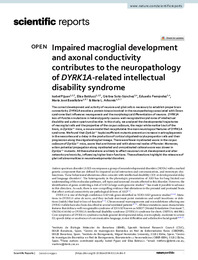Por favor, use este identificador para citar o enlazar este ítem:
https://hdl.handle.net/11000/34588
Impaired macroglial development and axonal conductivity contributes to the neuropathology
of DYRK1A‑related intellectual disability syndrome
Título :
Impaired macroglial development and axonal conductivity contributes to the neuropathology
of DYRK1A‑related intellectual disability syndrome |
Autor :
Pijuan, Isabel
Balducci, Elisa
Soto-Sánchez, Cristina 
Fernández, Eduardo
Barallobre, Maria Jose 
Arbonés, Maria L. |
Editor :
MDPI |
Departamento:
Departamentos de la UMH::Histología y Anatomía |
Fecha de publicación:
2022-11-19 |
URI :
https://hdl.handle.net/11000/34588 |
Resumen :
The correct development and activity of neurons and glial cells is necessary to establish proper brain connectivity. DYRK1A encodes a protein kinase involved in the neuropathology associated with Down syndrome that influences neurogenesis and the morphological differentiation of neurons. DYRK1A loss-of-function mutations in heterozygosity cause a well-recognizable syndrome of intellectual disability and autism spectrum disorder. In this study, we analysed the developmental trajectories of macroglial cells and the properties of the corpus callosum, the major white matter tract of the brain, in Dyrk1a+/- mice, a mouse model that recapitulates the main neurological features of DYRK1A syndrome. We found that Dyrk1a+/- haploinsufficient mutants present an increase in astrogliogenesis in the neocortex and a delay in the production of cortical oligodendrocyte progenitor cells and their progression along the oligodendroglial lineage. There were fewer myelinated axons in the corpus callosum of Dyrk1a+/- mice, axons that are thinner and with abnormal nodes of Ranvier. Moreover, action potential propagation along myelinated and unmyelinated callosal axons was slower in Dyrk1a+/- mutants. All these alterations are likely to affect neuronal circuit development and alter network synchronicity, influencing higher brain functions. These alterations highlight the relevance of glial cell abnormalities in neurodevelopmental disorders.
|
Tipo de documento :
info:eu-repo/semantics/article |
Derechos de acceso:
info:eu-repo/semantics/openAccess |
DOI :
10.1038/s41598-022-24284-5 |
Publicado en:
Sci Rep . 2022 Nov 19;12(1):19912 |
Aparece en las colecciones:
Artículos Histología y anatomía
|
 La licencia se describe como: Atribución-NonComercial-NoDerivada 4.0 Internacional.
La licencia se describe como: Atribución-NonComercial-NoDerivada 4.0 Internacional.

 La licencia se describe como: Atribución-NonComercial-NoDerivada 4.0 Internacional.
La licencia se describe como: Atribución-NonComercial-NoDerivada 4.0 Internacional.
.png)